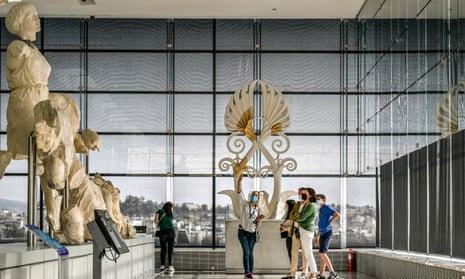The British Museum chairman, George Osborne, has mooted the possible return of the Parthenon (or Elgin) marbles to Greece. This is thoroughly good news. He is not the first to suggest a “marbles deal”, but he is the first to suggest that “seeing them in their splendour in Athens” is a virtue to be sought. More importantly, he seems to accept that this has passed on from the past history of their acquisition and the dry legal issue of ownership. Rather, it concerns the context in which we best display these glories of European civilisation.
One thing is clear. Having half the marbles under the shadow of the Acropolis in Athens and the other half in a frigid Bloomsbury chamber is wrong. It is not sharing a work of art; it is splitting one. This cavalcade of masterpieces should be properly shown together, and that means at the site of their creation, in Athens. Loaned, swapped, sold or whatever, they should go back to Greece. It is understandable that the Greeks have never ceased begging for their return.
The only issue is whether something can be done to appease the overweaning pride and hoarding instinct of the staff of the British Museum, who have come to regard the marbles as their personal property. There is now a clear answer to this: 3D printers under the auspices of the Institute of Digital Archaeology are currently reproducing several of the BM carvings, reportedly using stone from the original Pentelic quarries in Greece. This is despite an official complaint from the museum. They will reputedly be indistinguishable from the originals, blemishes and all.
This surely meets the museum’s aesthetic demand that the marbles be seen “among the splendours of other civilisations” in London. Europe’s museums are filled with replicas, good and bad, and the British Museum has plenty. The issue thus ceases to be aesthetic. Authenticity of origination may be a much debated topic, but these marbles can perfectly well be experienced visually in London – complete with their Athens colleagues, if that is what is desired.
The issue is therefore reduced to politics. Greece desperately wants its authentic “crown jewels” to join the rest. This would not necessarily “open the door” to the return of every pot and picture in Europe to places of origin, though the question of restitution is nowadays everywhere in play. The Greeks are passionate about these statues; and, frankly, the British are not. The copies can be in London, not Athens.
Greece can pay. It can offer statues in return or formulate some ingenious co-ownership agreement. This will allow the museum some degree of face-saving, and it should take it. If it can be resolved – and it is absurd it has gone on so long – then Greece will surely confer on Osborne the Byron award for saintly philhellenism. He would deserve it.
Simon Jenkins is a Guardian columnist

